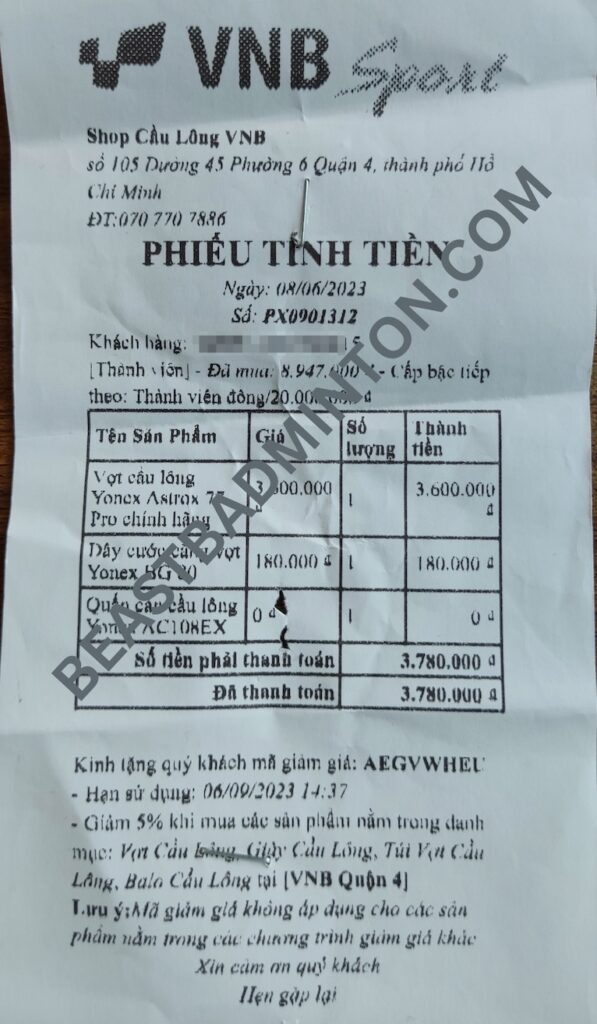
Before diving into the Astrox 77 Pro review, let me clear up any confusion around similar rackets.
The Astrox 77 Play is a more affordable model of the same racket intended for beginners, whereas the Pro (and Tour) models are for intermediate players and above.
The Tour model is reported to have nearly the same specs as the Pro but a more affordable price point as it’s manufactured in Taiwan rather than Japan, like the Pro.
The Pro is on the stiffer side of medium-stiff, meaning that it’s not forgiving enough for most lower- and mid-intermediate players to have fun with. I see it as suitable for upper intermediate players and above, and I’ll explain in detail why in this review.

Enough hoo-ha, let’s get down to business and see how this racket stacks up compared to others in this Yonex Astrox 77 Pro review!
Table of Contents
Yonex Astrox 77 Pro review
The factory strings and tension it comes with weren’t nice, so I immediately got it restrung to my standard Yonex BG80 at 10.5 KG in order to compare it against the other rackets I’ve tested. The BG80 is a power (repulsion) string.
I’ve had the racket on court for just over ten hours across both social games and training drills, and as always on the blog, I’m reviewing the 4U weight class with intermediate and beginner players in mind.
My first impression
I was curious about this Pro model as the Astrox 77 Play was far too flexible for my liking. On the other hand, I was also wondering if my skills would be up to the task of taming it as I expected it to be the stiffest racket I’ve tested yet.
At a price point 2.3x higher than that of the Play-model, I was intrigued to find out if it was also 2.3x smoother and worth the extra money.
The first thing I noticed was that the cover it came with felt softer and with better insulation. A more premium experience overall.
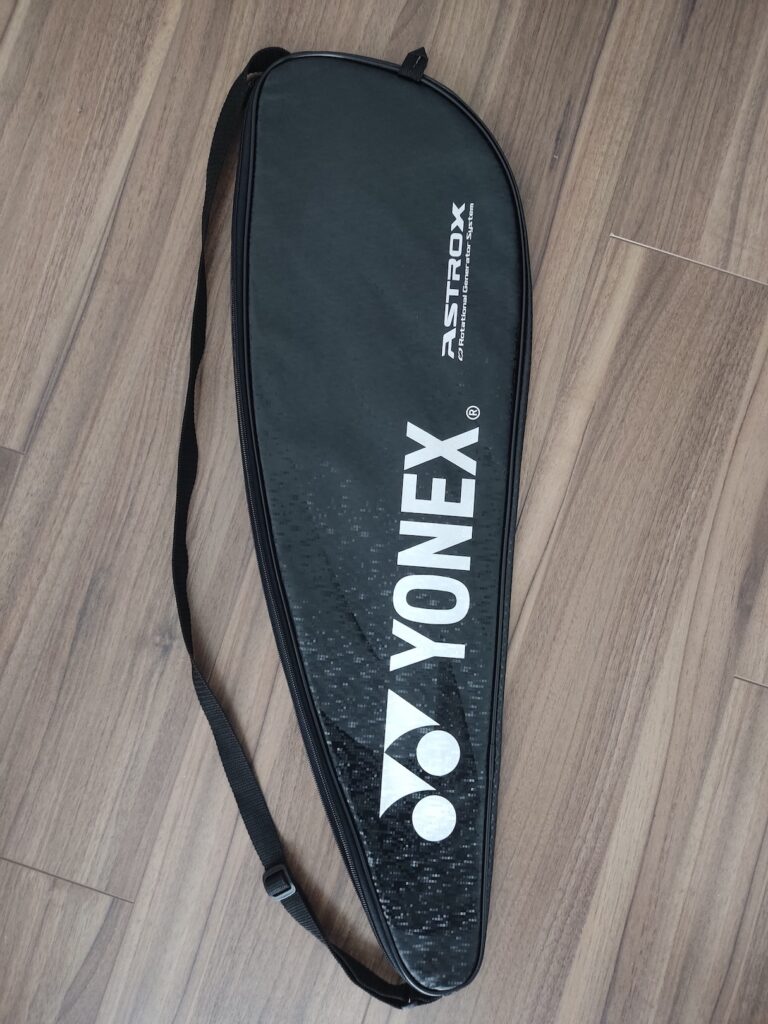
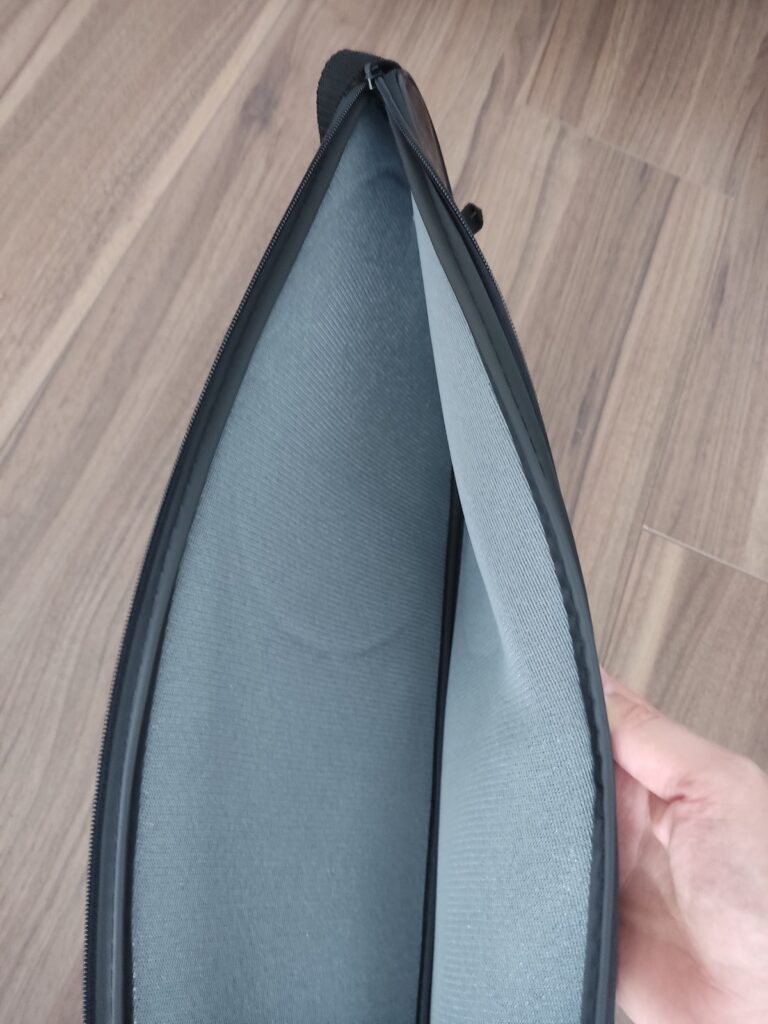
Upon inspecting the racket, I noticed that the stock grip feels nicer too. Not that it matters as I prefer playing with an overgrip but it’s nice to appreciate the small details in a new toy.
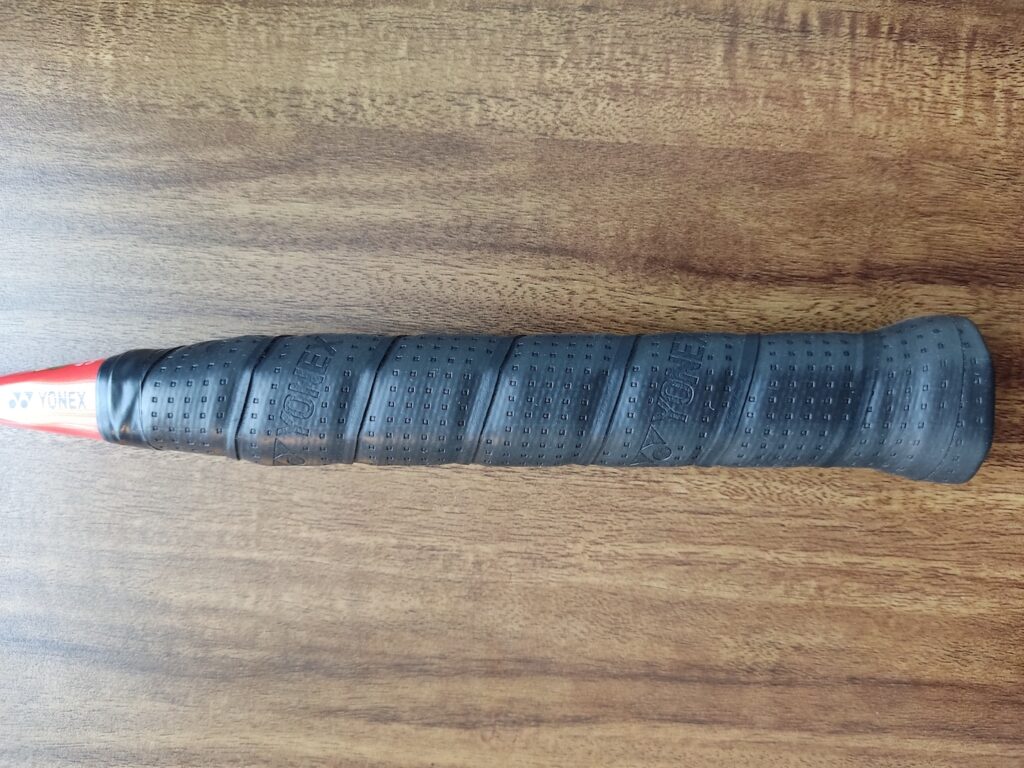
The best way to explain to a low-intermediate player what it felt like to play with this racket for the first time is with this note taken directly from my notebook:
“Wow, stiff!”
Yonex’s Pro-rackets is their flagship series used by professional players. This particular model is less stiff (more forgiving) than most of the other rackets in that series, so I can only imagine how crazy the professional players’ rackets must be.
In fact, this racket serves as a good reference point to what’s just a tad too stiff for players at this level.
Let’s look at how this racket feels to play in different aspects of the game, starting with net play.
Net play
As expected, it’s certainly easier to control the shuttle with this racket on soft, precise, touches compared to playing with typical attacking and power-based rackets.
The slight head weight means you still have to be careful not to overdo it. It creates this odd middle ground between holding back, and controlling the power, yet still requiring a tiny whip to avoid the shuttle flying short of the net.
Most rackets in the Astrox-series are more powerful and compared to them, you can expect more control than most with the Astrox 77 Pro.
The Energy Boost CAP PLUS handle cap didn’t feel like anything special despite being a highlighted part of the marketing material. Yonex describes certain benefits in terms of flexing and stability that you’ll be able to find in the section on the technology used in the racket later in this review.
At this point, I might simply not be skilled enough to tell the difference between that one and the Energy Boost CAP used on Game-models like the Astrox 100 Game. In fact, I prefer the flatter Energy Boost CAP as the touch makes it easier to sense where the top of the handle is when gripping the racket without looking.

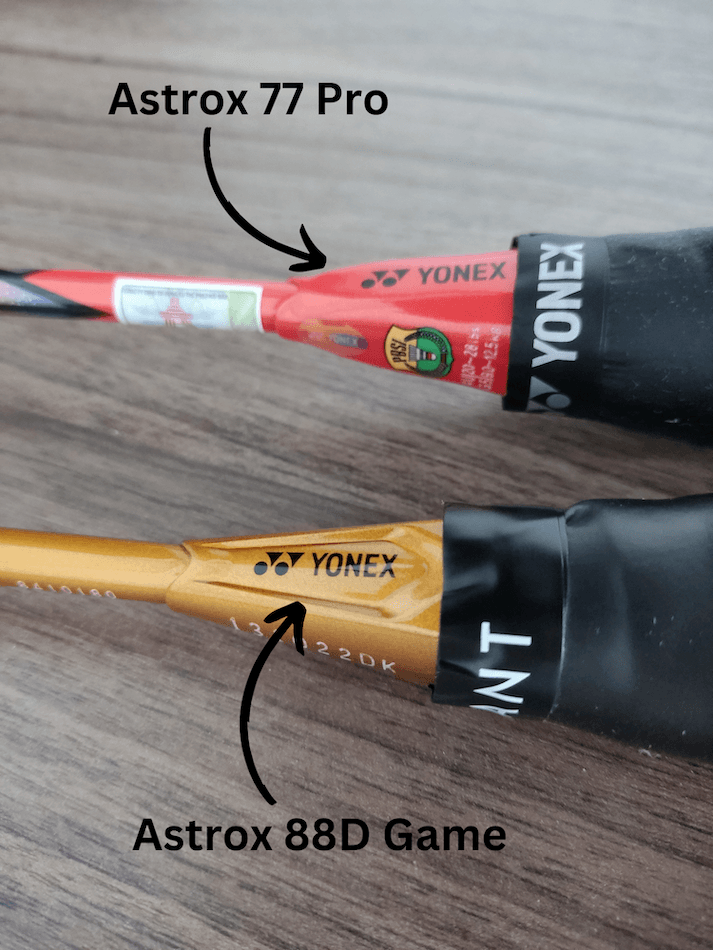
Midcourt and defense
Fast, intense, drive duels felt slightly easier with the Play-racket whereas the Pro required a perfect stroke every time, making it tricky when your opponent is machine-gunning shuttles at you with lightning speed. It took me a while to adjust but when I got it right, I found it easier to generate power than with the Play-model. That made it more likely that my opponents would respond off-balance.
Soft push shots and smash blocks felt good but if you are used to a more powerful racket, it’ll be tempting to let the shuttle bounce off the strings without adding any power. That doesn’t work as well with the Astrox 77 Pro and I found myself needing to give at least a tiny swing to get the same result.
If you’re like me and enjoy attacking with power-rackets, it’s a bitch to adjust to at first. The alternative is awkward situations where you have an easy shot but send it into the net.
Power (and attack)
Clears feel decent but do require a tad more technique than your typical attacking racket. The Astrox 77 Pro’s head weight felt nice on drop shots as well. Almost as if it gives that little extra push intermediate players need to let it sail over the net rather than just coming up short (if the technique isn’t perfect or you hit it off balance).
Fast drops felt easier to perform and cleaner than with the 77 Play, which may come down to the stiffness of this model.
I know you’ll kill me if I don’t mention raw power and smash, but don’t worry. I saved the best for last.
I found my power smash to be the hardest stroke to pull off cleanly with the Yonex Astrox 77 Pro. I still haven’t adjusted fully and I sense that my technique might not be good enough. Out of ten hits in a smash drill, I’d hit just a few clean smashes and the rest would go in the net.
The ones I did hit cleanly felt amazing and like a baseball bat hitting a tennis ball. I was surprised by how much power the extra stiffness helped me generate — not to mention the crisp sound!
This is one thing during drills where you’re not under pressure, but in games, it became frustrating to the point where I’d have to avoid smashing altogether as my confidence in this stroke was gone.
Impulsive smash on a lift when you’re not in a perfect position?
Forget about it.
Instead, I had to rely on other, more creative, tactics to win the rallies (which is one way to force yourself to practice that, I guess).
I found the bit of extra head weight to be nice when you get tired, as it helps push shots over the net when you’re ultra late.
I particularly noticed this on deep lifts when I was late to the shuttle compared to, say, the Arcsaber 11 Play which feels like a similar racket.
Conclusion
The Astrox 77-series is generally easy to get used to as it’s good all around. If you’re a typical intermediate player like me though, the stiffness in the Pro-model will take some getting used to and the question is if you’re ready to work on your technique enough to take advantage of it.
The Yonex Astrox 77 Pro feels challenging to master as an intermediate player, but more fun on shots that aren’t as easy to mess up as a smash. The slight head weight feels more noticeable to me here than in the Play-model. Despite that, Play and Pro don’t feel that different, which is an impressive feat for the Play considering just how affordable it is.
In fact, the Astrox 77 Pro doesn’t feel like it’s worth the money unless you’re an upper intermediate player moving into the advanced level and prefer stiffer rackets anyway. Instead, the Arcsaber 11 Play costs less than half and feels similar to play with.
The difference between the two rackets is that where the Astrox 77 Pro offers that bit of extra power, the Arcsaber 11 Play gives slightly more control instead. Some players might not even notice the difference.
If I had to say something positive and negative about Yonex Astrox 77 Pro
POSITIVE
If you don’t know which racket to get, the Astrox 77 (whether Play or Pro) is a good place to start.
NEGATIVE
To the naked eye, this racket can feel bland and like it doesn’t clearly help you in any specific area of the game as you might be familiar with from other rackets.
Hey reader, a quick interruption... I’m experimenting partnering with webshops that sell badminton gear, like Amazon. I’ll include links to buy the gear I review and if you do, they’ll pay me a small commission. That doesn’t change your price and you’ll get more play-tested gear as a result but I thought it was fair to let you know. As an Amazon Associate, I earn from qualifying purchases. I appreciate your support, Aske
Yonex Astrox 77 Pro: the verdict

Summary
The Astrox 77 Pro is an all-around racket for upper-intermediate players and above. It’s not amazing in one area but strong across the board.
In my experience, it’s not forgiving enough for the average intermediate player to enjoy, especially when smashing.
The price tag doesn’t seem worth it for intermediate players as Yonex has other similar rackets that offer as much fun (if not more) for half the price.
Yonex Astrox 77 Pro marketing and technology
Here’s an overview of the marketing and technology used for the Yonex Astrox 77 Pro.
As we often see with badminton brands, this racket also comes with a claim that isn’t clearly proven or at least clarified: “This new model features new technologies for better performances and a 2.9% increase in smash power.”
| Yonex Astrox 77 Pro Technology | Description |
|---|---|
| AERO+BOX Frame | A combination of two frame styles. One for power and one for a quick swing |
| ISOMETRIC | Increases the size of the sweet spot (available on all newer Yonex rackets) |
| Rotational Generator System | To generate better whip effect through counter balancing |
| Super Slim Shaft | To make it easier to slice through the air (this is the slimmest shaft Yonex has produced and is said to reduce air resistance) |
| Flex Fuse | Placed in the joint, this shock absorbing resin is said to create a comfortable hitting feel |
| Namd | Placed in the shaft, it's said to increase flex and snap back speed to help produce explosive smashes. It seems well suited for stick smashes |
| Energy Boost CAP PLUS | Said to help the shaft flex, while stabilizing the racquet by preventing the shaft from twisting |
Best player types for Yonex Astrox 77 Pro
Next, let’s look at which player types this racket is ideal for and who should avoid it.
The ideal player type
The Astrox 77 Pro is well suited for upper intermediate players and above – it’s popular among many professional players on the World Tour as well.
Besides the skill level, it’s a good fit for a creative, versatile playing style that isn’t overly dependent on power smashing your opponents in the ground, for example.
The non-ideal player type (you might not like this racket if…)
If you’re a beginner or low-mid intermediate player, you’ll likely find this racket too unforgiving as it requires you to be on your A-game constantly. Don’t get this racket too early in your badminton “career”.
Besides, if you love power there are also better-suited options out there, like the Astrox 100 Game.
Yonex Astrox 77 Pro compared to other popular rackets
Let’s look at how the Astrox 77 Pro stacks up against Astrox 77 Play, Arcsaber 11 Play, and Astrox 100 Game, the latter two feeling similar in terms of stiffness.
Astrox 77 Pro vs. Astrox 77 Play
The Astrox 77 Play and Astrox 77 Pro are surprisingly similar considering the difference in price. They are both solid rackets across the board and fairly easy to play with as they aren’t super fast or powerful.
The Play feels crazy flexible and forgiving in your game, most noticeable when smashing. In my experience, unless you’re a beginner and new to badminton, the Play is too flexible as it’s perhaps the most flexible power-based racket Yonex offers at the moment.
Yonex has been making a Game-model for intermediate players in other similar racket-series, but they haven’t made one for the Astrox 77 at the time of writing this.
If you fall in love with the 77 Play model and want to get a better racket as you improve your skills, there isn’t a good fit in the 77-series for low intermediate and mid-intermediate players.
I get why there isn’t a Game-model for this series, though, as there are several other rackets in Yonex arsenal that have similar specs and fall somewhere in the middle.
Astrox 77 Pro vs. Arcsaber 11 Play
When comparing the stiffness between Astrox 77 Pro and Arcsaber 11 Play in Yonex catalogs, they are far apart but that really wasn’t my experience on court.
Sure, the Astrox 77 Pro felt stiffer but not by much except when smashing. That extra stiffness means it’ll be less forgiving, which you’ll especially feel on off days when you’re tired.


These two rackets felt similar across the board and functions well as all-around rackets that are effective in just about anything but without crazy power or speed.
For the low-mid intermediate player, I’d suggest the Arcsaber as it’s more affordable and you’ll lose fewer points being tempted to smash during games. At this point, I’d argue that the Arcsaber 11 Play feels like the perfect intermediate racket as it forces you to train creative things on court.
The way I look at it, they both take 85% of the same approach to the game but where the Astrox 77 Pro offers slightly more power, which I especially noticed in late lifts as they became slightly easier, the Arcsaber 11 Play offers slightly more precision and control in your shots.
Whether you prefer precision and control over power is up to you.
Astrox 77 Pro vs. Astrox 100 Game
The Astrox 77 Pro feels stiffer than the Astrox 100 Game despite Yonex’s matrix suggesting that it’s roughly the same in their catalog.

The 100 Game feels faster and slimmer, like a ninja sword that slices holes in the air – it feels smoother.
At the same time, the 77 Pro feels heavier in a way that’s hard to describe. Maybe it’s the stiffness since it’s less head heavy than the Astrox 100 Game.
I find myself hitting more flat fast shots (not counting smash) with the 100 Game and more slow and arch-like shots with the 77 Pro. It requires some adjustment in doubles on the mid-court.
With the 77 Pro, I was able to perform a decent backhand considering my subpar technique (maybe slightly better than the 100 Game even), but I didn’t get as much power as with 100 Game.
Yonex Astrox 77 Pro Specifications
| Flex | Medium |
| Balance Point | Head Heavy |
| Weight / Grip | 4U G5, 6 3U G4, 5, 6 |
Recommended strings
| Yonex’s recommended strings | Control Players: AEROBITE Hard Hitters: EXBOLT65 |
8 comments
Bro, try to find some different stores. VNB usually has higher prices than the rest. Not always tho, but still higher most of the time.
Interesting. Do you have any suggestions besides VNB and Luong Sport?
You can also consider FBShop. They usually have a pretty good price.
Thanks for the heads up – I’ll check with them as well. Hopefully, they are flexible on shoe sizes
No problem bro. Really enjoyed reading your reviews
Well, try the Astrox 70 4U. I’ve been wanting to try the Astrox 77 Pro but I’m afraid due to its stiffness I can’t throughly maximize its capabilities. The Astrox 70 is like the cousin of 77 but more user friendly. It’s not a specialty racket but it gets the job done.
Sounds like a good choice. I’m curious to hear about your experience – I hope you’ll share when you’ve got a chance to play with it.
Hi, it doesn’t come with factory strings, rather unstrung. Maybe yours was fake?